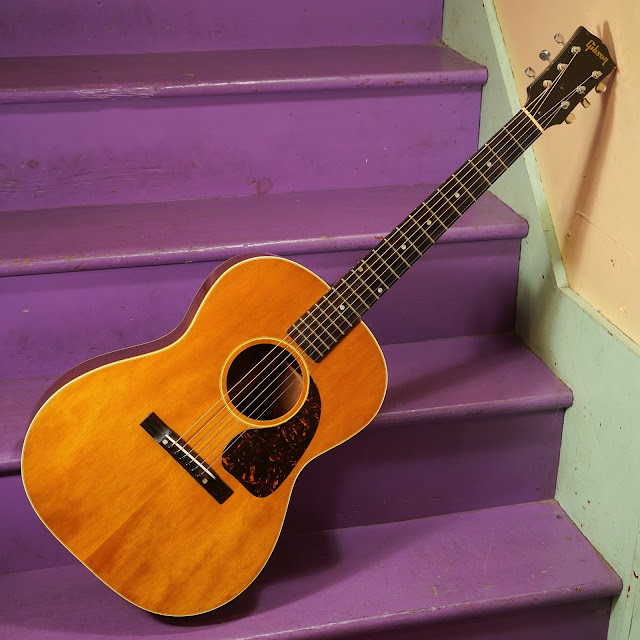1950s Gibson LG-3 Flattop Guitar
It's often hard to pin-down the exact year of manufacture for Gibsons of this era. It lacks an original factory order number and so, judging by features, this has to place from the late '40s into the early '50s. It has scalloped x-bracing and the small pickguard as well as a chunkier neck which probably suggests that it's around 1949-1952 or so. I say that just from past experiences with confirmed-year LG-2 and LG-3 boxes that've come through the shop.
At any rate, that puts it right in the sweet spot as far as I'm concerned. Both my favorite Martins and my favorite Gibsons date from the early '50s. Both companies had left the overly-light builds of the '30s and early '40s behind and their postwar efforts are a little more practical and stable in build while also sounding killer. This LG-3 has just what you want from a Gibson of this style -- a woody, somewhat dry sound, with lots of mids, a round bottom, clean and present top, and a good "blend" to a chord where you hear all the notes but they gel into a "whole." It's also punchy and can cut pretty nicely, too.
Fingerpickers like these for their clean, bluesy, woody sound with bare fingers and flatpickers like these as old-time fiddle-backup boxes. They're not as snappy as a Martin when flatpicking lead but they're perfect for bass-run/chord-chop stuff behind a voice and the plainspoken sound to single-note lines means you will hear them in a mix.
This particular guitar's been played a bunch but looks great. It's all-original, too, with the exception of tuners, pins, saddle, and one top brace. After a bunch of work it plays perfectly and is nice and stable and ready to go.
Repairs included: a neck reset, fret level/dress, new bone saddles (two -- one tall, one short), brace reglue jobs on the back and a number of them on the top, one replacement brace install (a non-tone-changing one: it's the ladder brace just above the soundhole and I used 150+ year-old tight-grain spruce for it), re-repair to a couple of longer treble-side cracks running from the endblock area, pickup jack-hole fill, and replacement strap button (Gibson-style) installs plus a setup.
Top wood: solid spruce
Back & sides wood: solid mahogany
Bracing type: x, scalloped
Bridge: rosewood
Fretboard: rosewood
Neck wood: mahogany
Action height at 12th fret: 3/32” bass 1/16” treble (fast, spot-on)
String gauges: 54w-12 lights
Neck shape: medium C
Board radius: ~10-12"
Truss rod: adjustable
Neck relief: straight
Fret style: small/low
Scale length: 24 7/8"
Nut width: 1 11/16"
Body width: 14 3/8"
Body depth: 4 3/8"
Condition notes: the tuners, saddle, bridge pins, and strap buttons are replacements. There are a a few longer repaired hairline cracks on the treble side running from the endblock. One (my original repair) is flush and almost invisible while the other (an older repair) is not 100% flush. Both are hard to see at a glance and are backed with glued canvas "cleats." A pickup was removed and the endpin jack-hole was filled and a strap button installed in the same place. The finish is all-original and looks great but has the usual weather-check/cracking and mild usewear you'd expect to see on a Gibson this old. The back near the heel has a secondary strap button hole that's filled and the back of the neck has a bit of minor wear as well. S1466 is stamped in the back of the headstock and while it looks like a 1959 factory order number, it's not. The features of this guitar clearly make it a late-'40s or early-'50s instrument.
It comes with: a good, oversize hard case.



















Comments